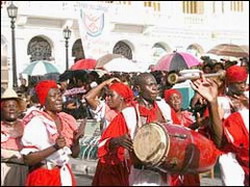Summer in Cuba, a major tourist destination in the Caribbean region, is an excellent period to enjoy your vacations
- Submitted by: admin
- Travel and Tourism
- Arts and Culture
- Caribbean
- culture an traditions
- Dance
- Destinations
- Entertainment
- Music
- national
- Society
- 06 / 18 / 2008

That is the case of Havana's Carnivals, which are one of the oldest traditions in the country and were first held centuries ago, on the day of Corpus Christi and the Epiphany, when the African slaves used to dance and march.
Authorized by their Spanish masters, the African slaves enjoyed some days off once a year, in addition to January 6, on the Epiphany, when they were allowed to sing and dance as they used to do in Africa.
Dates have changed as time went by, so carnivals are currently held in summer time, when most people enjoyed their vacations.
Salsa music and color are animated by dance groups founded several years ago. That is the case of prominent dance groups such as La Jardinera, La Giraldilla de La Habana, Guaracheros de Regla, Los Marqueses de Atarés
Many of those groups, most of which were founded in Havana neighborhoods, pass their knowledge on children, who also enjoy the carnival.
For those who take part in the carnivals for the first time, the combination of summer heat, traditional dances and rhythm – usually accompanied by drums or the acute sound of a Chinese trumpet – creates a feeling of belonging that urges them to participate in such festivities again.
Every year, the audience becomes active participants, moved by the music of popular orchestras that encourage them to dance, regardless their country of origin.
Each region's carnival has its own characteristics. The most famous ones are those held in eastern Santiago de Cuba, Remedios and the Cuban capital.
There is even a Carnival Museum in Santiago de Cuba, where visitors can learn about the history of those traditional festivities.
The museum is aimed at keeping tradition alive, so its seven halls hold more than 250 artifacts, including photos, costumes and musical instruments used in such festivities.
The combination of cultures in Cuba created greater dance and rhythmic diversity, the use of costumes and other distinctive elements that turn carnivals into very attractive shows.
Tourist programs in Cuba are complemented by tours of cities with rich architectural values in a perfect state of preservation, hotels linked to plastic arts, patrimonial sites and a wide range of celebrations and festivities.
(DTCuba)
Comments